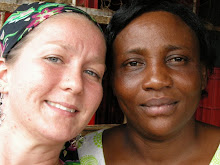Information on Tanzania from
The Peace Corps Welcome Book
you can read all 107 pages at:
http://www.peacecorps.gov/welcomebooks/tzwb621.pdf
People and Culture: The population of Tanzania consists of more than 120 native African groups, the majority of whom speak a Bantu language. The largest groups are the Sukuma and the Nyamwezi, each representing about a fifth of the population. Tanzania is also home to people of Indian, Pakistani, and Goan origin, and small Arab and European communities.
 The population of Tanzania is estimated to be close to 32 million, giving the country a population density of 106 people per square mile. The population distribution is irregular, with high densities in the fertile areas around Mount Kilimanjaro and the shores of Lake Victoria and comparatively low densities in much of the interior.
The population of Tanzania is estimated to be close to 32 million, giving the country a population density of 106 people per square mile. The population distribution is irregular, with high densities in the fertile areas around Mount Kilimanjaro and the shores of Lake Victoria and comparatively low densities in much of the interior.
Muslims, Christians, and those with indigenous beliefs make up relatively equal proportions of Tanzania’s population. Muslims live mainly along the coast and on Zanzibar, while Christians reside primarily inland and in the larger cities. Animist beliefs are still strong in many areas of the country.Economy: The economy of Tanzania is primarily agricultural. About 80 percent of the economically active population is engaged in farming, and agricultural products account for about 85 percent of annual exports. The country is the world’s largest producer of cloves. Other products include tea, coffee, cashew nuts, sisal, timber, and cotton. In recent years, the mining industry has developed significantly, with gold, tanzanite, and diamonds providing jobs and income. The manufacturing sector is small and growing slowly.
With per capita income at an estimated $270 a year in 2002, Tanzania is one of the poorest countries in the world.
History: Most experts agree that the earliest humans originated in fertile regions of East Africa. Cushitic-speaking people from southern Ethiopia migrated through the eastern part of the Great Rift Valley into north central Tanzania during the first millennium B.C. Early cattle herders found an unoccupied niche in the virgin grasslands and coexisted with the Khoisan hunters and gatherers who were already there. During the first millennium A.D., Bantu-speaking peoples originating from west central Africa filtered into western Tanzania and the fertile volcanic mountains of the northeast. These ironworking cultivators preferred wetter areas and thus avoided the dry savannas that were already occupied by hunters, gatherers and pastoralists.
In its desire to establish an economic and political foothold among other European powers, a newly unified Germany entered mainland Tanzania in 1884 and signed a series of agreements with local rulers that ceded administrative and commercial protection to Germany. With the onset of World War I, Germany lost control of mainland Tanzania. Great Britain took over and renamed the mainland Tanganyika. In 1922, the League of Nations consigned Tanganyika to the British Empire under its mandate system. It was not until 1961 that Tanganyika gained independence from Britain, with Julius Nyerere serving as the country’s first president.
Government: The United Republic of Tanzania was formed on April 26, 1964, by the adoption of the Act of Union between Tanganyika and the islands of Zanzibar. The nation is governed under a Constitution formulated in 1977. The chief executive of Tanzania is a president, currently Jakaya Kikwete, who is elected by popular vote to a five-year term. The president appoints a vice president, prime minister, and cabinet.
Environment: The landscape of mainland Tanzania is generally flat along the coast, but a plateau with an average altitude of about 4,000 feet constitutes the majority of the country. Isolated mountain groups rise in the northeast and southwest. The volcanic Kilimanjaro (the highest mountain in Africa at 19,340 feet) is located near the northeastern border. Three of the great lakes of Africa lie on the Tanzanian border: Lake Victoria in the northwest, Lake Nyasa (also called Lake Malawi) in the southwest, and Lake Tanganyika in the west. The latter two rivers lie in the Great Rift Valley, a tremendous geological fault system that extends from the Middle East to Mozambique.
Peace Corps in Tanzania: Peace Corps Volunteers first arrived in Tanzania (then called Tanganyika) in 1962. Since then, approximately 2,000 Volunteers have served in Tanzania, working in education, health, the environment, and agriculture. In the early years of Peace Corps/Tanzania, most Volunteers focused on education.
As a relatively small player in a country of almost 36 million people, Peace Corps/Tanzania recognizes the need for a strategic vision that focuses on niche areas, where a small number of dedicated Volunteers can make a significant difference. Our projects are in areas where we can play a catalytic or model-building role while meeting Tanzania’s real, identified needs. Thus, our projects in education, health, and the environment have the potential to make a real difference in Tanzania. Our focus on youth, particularly in the areas of environmental education, empowerment of girls, and HIV/AIDS prevention and care, serves our overall “country theme,” as it empowers young people to take greater control of their lives and to be responsible, active members of their communities.
 The population of
The population of 







